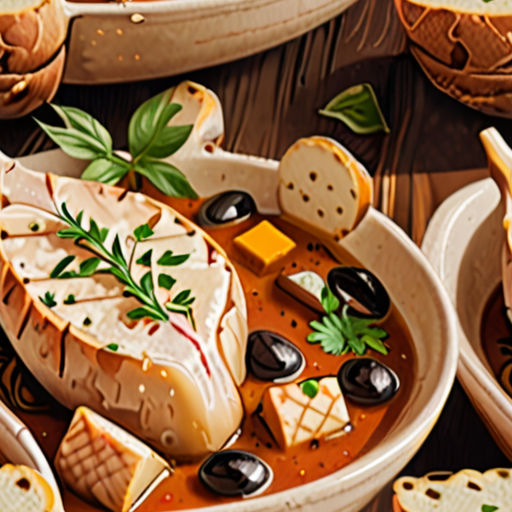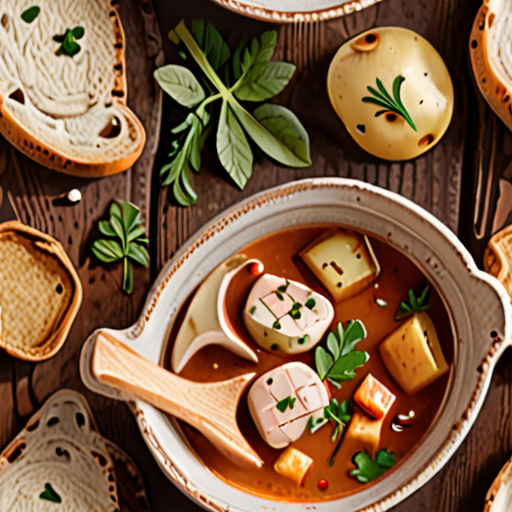When it comes to cooking a delicious and satisfying meal, few options are as appealing as a hearty fish stew. This classic dish has been a staple of coastal cuisine for centuries, and its enduring popularity is a testament to its versatility and ease of preparation. Whether you’re a seasoned chef or a beginner in the kitchen, mastering the art of making easy fish stew recipes can elevate your culinary skills and provide a comforting, flavorful meal for family and friends.

Choosing the Best Fish for Stewing
The perfect fish for stewing depends on personal preference, texture, and flavor.
- Firm White Fish:
- Halibut : A popular choice for its rich flavor and flaky texture.
- Cod : Mild flavor and tender flesh make it ideal for stews.
- Red Snapper : Sweet flavor and firm texture work well in hearty stews.
- Fatty Fish:
- Tilapia : Delicate flavor and soft texture require gentle handling in stews.
- Sole : Flaky texture and mild flavor make it suitable for light stews.
- Oily Fish:
- Tuna : Strong flavor and meaty texture may overpower other ingredients.
- Mix-and-Match Options:
- Shrimp , Clams , and Scallops : Add protein-rich seafood to enhance flavor and texture.
When selecting fish for stewing, consider factors like freshness, sustainability, and local availability to ensure the best possible outcome.
For a delicious and satisfying stew, combine your chosen fish with aromatic vegetables, herbs, and spices, and simmer until the flavors meld together.
Experiment with different fish varieties and seasonings to find your perfect combination.
Difference Between Fish Stew and Fish Soup
Fish stew and fish soup are two popular seafood dishes that share similarities but also have distinct differences.
- Cooking Method
- Fish stew is typically cooked at a low temperature with a closed lid, resulting in a thicker and chunkier consistency compared to fish soup.
- Fish soup, on the other hand, may be cooked more quickly and has a higher liquid content than fish stew.
- This difference in cooking method affects the texture and flavor of the final dish.
- Consistency
- Fish stew tends to be chunkier due to the larger pieces of fish and vegetables used in its preparation.
- In contrast, fish soup often has a thinner consistency and may include smaller pieces of fish and vegetables.
- The choice of ingredients and cooking method contributes to the varying consistencies of these two dishes.
- Liquid Content
- Fish stew generally has less liquid than fish soup, which can result in a heartier and more filling meal.
- Fish soup, with its higher liquid content, can be served as a lighter and more brothy option.
- The liquid content also impacts the overall flavor profile of the dish.
Ultimately, the distinction between fish stew and fish soup lies in their cooking methods, consistencies, and liquid contents.
While both dishes offer delicious and satisfying options for seafood lovers, understanding their differences can help you choose the perfect recipe for your next meal.

Thickening Fish Stew
To achieve the perfect consistency in your fish stew, try these methods:
- Reduce the Liquid : Allow the stew to simmer for a longer period, which helps to evaporate excess liquid and thicken the sauce.
- Add Thickening Agents : Use ingredients like cornstarch, flour, or tapioca starch mixed with water to create a slurry, then stir it into the stew.
- Use Roux : Mix equal parts of butter and flour to create a roux, then cook it until it reaches a dark brown color before adding it to the stew.
- Add Pureed Vegetables : Blend cooked vegetables like carrots or potatoes to create a thick paste, then add it to the stew.
- Simmer with Tomatoes : Cooking tomatoes down reduces their liquid content, making the stew thicker and more flavorful.
When thickening your fish stew, remember to taste and adjust the seasoning accordingly. You can always add more liquid if needed, but it’s harder to remove excess liquid once added.
For a richer flavor, try adding a splash of heavy cream or coconut milk towards the end of cooking time. This adds a creamy texture without overpowering the delicate flavors of the fish.
Experiment with different combinations of these methods to find the perfect balance for your fish stew. Remember to always cook with love and patience, as a well-made stew is a true reflection of your care and attention.

How to Cook Fish for Beginners
Cooking fish can seem intimidating, but with the right techniques and ingredients, anyone can become a pro.
-
Pan-Seared Fish
To pan-sear fish, start by seasoning the fish with salt, pepper, and any other herbs or spices you like. Heat a skillet over medium-high heat and add a small amount of oil. Place the fish in the skillet and sear for 2-3 minutes on each side, or until cooked through.
-
Baked Fish
To bake fish, preheat your oven to 400°F (200°C). Season the fish as desired and place it on a baking sheet lined with parchment paper. Drizzle with olive oil and bake for 8-12 minutes, or until cooked through.
-
Grilled Fish
To grill fish, preheat your grill to medium-high heat. Season the fish as desired and place it on the grill. Cook for 2-3 minutes per side, or until cooked through.
-
Boiled Fish
To boil fish, fill a pot with water and bring it to a boil. Add the fish and cook for 8-12 minutes, or until cooked through.
Tips and Tricks
When cooking fish, it’s essential to handle it gently to prevent breaking the flesh. Use a gentle touch when placing the fish in the pan or on the grill, and avoid pressing down on it with your spatula.
Another crucial tip is to not overcrowd the pan or grill. Cook the fish in batches if necessary, to ensure that each piece has enough room to cook evenly.
Finally, don’t be afraid to experiment with different seasonings and marinades to find the flavor combination that works best for you.
Common Mistakes to Avoid
One common mistake when cooking fish is overcooking it. To avoid this, use a thermometer to check the internal temperature of the fish. For most types of fish, the internal temperature should reach 145°F (63°C).
Another mistake is not patting the fish dry before cooking. Patting the fish dry helps remove excess moisture, which can prevent the fish from cooking evenly.
Conclusion
The Most Common Mistake When Cooking Fish
When it comes to cooking fish, there are several common mistakes that can result in a less-than-desirable dish.
- Overcooking
- Internal Temperature Guidelines:
- Incorrect Pan Temperature
- Pan Temperature Tips:
- Lack of Seasoning
- Seasoning Ideas:
- Inadequate Oil Usage
- Oil Usage Tips:
One of the most common mistakes when cooking fish is overcooking it. Overcooked fish can become dry, tasteless, and tough, which is why it’s essential to cook it just until it reaches the recommended internal temperature.
Fish should be cooked to an internal temperature of at least 145°F (63°C), but it’s crucial to check the temperature regularly to avoid overcooking.
Another common mistake is cooking fish in a pan that’s too hot or too cold. A medium-high heat is usually ideal for cooking fish, as it allows for even browning and prevents the fish from sticking to the pan.
To achieve the perfect pan temperature, place a small piece of oil in the pan and let it heat up for a minute or two before adding the fish.
Cooking fish without seasoning can result in a bland and unappetizing dish. Make sure to season the fish with salt, pepper, and any other herbs or spices you prefer before cooking it.
Some popular seasoning options for fish include lemon juice, garlic powder, paprika, and dill weed.
Cooking fish without enough oil can cause it to stick to the pan and become dry. Use a sufficient amount of oil to prevent this from happening.
A general rule of thumb is to use about 1-2 tablespoons of oil per serving of fish.
By avoiding these common mistakes, you can ensure that your fish dishes turn out delicious and satisfying every time.

The Best Seasonings for Fish
When it comes to seasoning fish, there are several options to choose from, depending on personal taste preferences and the type of fish being cooked.
- Lemon Pepper: A classic combination of lemon zest and black pepper adds a bright, citrusy flavor to fish without overpowering its delicate taste.
- Herbs de Provence: This French herb blend typically includes thyme, rosemary, oregano, and lavender, which pairs well with Mediterranean-style fish dishes.
- Cajun Seasoning: A spicy mix of paprika, garlic powder, onion powder, and cayenne pepper adds a bold kick to fish, perfect for those who enjoy a little heat.
- Asian-Glazed: A sweet and savory combination of soy sauce, honey, ginger, and sesame oil creates a sticky glaze that complements the rich flavor of fatty fish like salmon.
- Mediterranean Oregano: This earthy, slightly bitter herb is commonly used in Greek and Italian cuisine, adding depth and warmth to fish dishes.
Some popular seasonings for fish include Old Bay, dill weed, parsley, basil, and chili powder, among others.
When selecting a seasoning for fish, consider the type of fish, its fat content, and the cooking method to ensure the best flavor outcome.
For example, delicate fish like sole or flounder may benefit from lighter seasonings like lemon pepper or herbs de Provence, while heartier fish like tuna or swordfish can handle bolder flavors like Cajun seasoning or Asian-glazed.
Ultimately, the best seasoning for fish is one that enhances its natural flavor without overpowering it.
Tips for Seasoning Fish
- Experiment with different combinations of herbs and spices to find the perfect balance of flavors.
- Don’t overseason fish, as this can lead to an overpowering flavor.
- Consider the cooking method when selecting a seasoning, as some seasonings may burn or become bitter during high-heat cooking.
- Let fish sit for a few minutes before serving to allow the seasonings to penetrate the flesh.
Conclusion
With these seasonings and tips, you’ll be well on your way to creating delicious and flavorful fish dishes that showcase the beauty of fresh seafood.

0 Comments